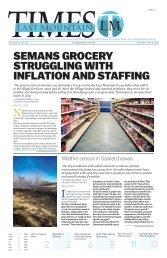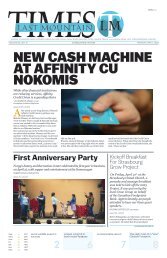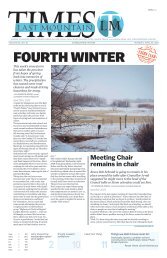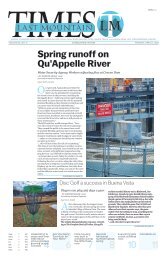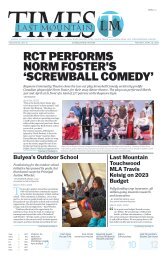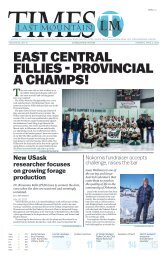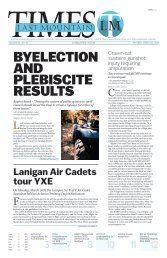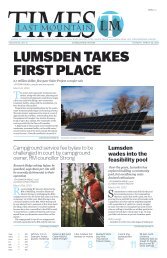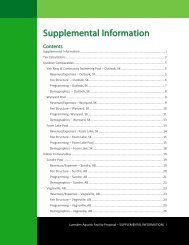Last Mountain Times June 11 2018
You also want an ePaper? Increase the reach of your titles
YUMPU automatically turns print PDFs into web optimized ePapers that Google loves.
NEWS BRIEFS<br />
Sask dead last in job growth<br />
For the second month in a row, numbers released<br />
by Statistics Canada show Saskatchewan having the<br />
worst job growth in Canada. In May <strong>2018</strong>, 7,300<br />
fewer people were working in Saskatchewan than in<br />
May 2017.<br />
“It’s disappointing to see our economy suffering<br />
and our workers struggling to find and keep<br />
employment. When you see job numbers like these,<br />
you can understand why people are leaving Saskatchewan<br />
for better opportunities in other provinces,”<br />
said NDP Jobs Critic Vicki Mowat.<br />
Saskatchewan again had the highest unemployment<br />
rate outside of Atlantic Canada at 6.9 per cent,<br />
with Alberta’s unemployment rate at 6.5 per cent<br />
and Manitoba’s at 6.4 per cent. In May <strong>2018</strong>, 34,700<br />
more people were working in Alberta than in May<br />
2017 and 2,600 more in Manitoba for that same<br />
time period.<br />
The construction sector lost 4,800 jobs, 3,100<br />
jobs were lost in trade and 4,600 jobs were lost in<br />
professional, scientific and technical services.<br />
Recreational property prices forecast to<br />
increase<br />
According to a cross-Canada survey of recreational<br />
property specialists, the nation’s recreational<br />
property market is primed for healthy single-digit<br />
growth in <strong>2018</strong>, as buyers across the land flock to<br />
lakes and streams, and the seaside and mountain<br />
tops, with an eye towards retirement or a secondary<br />
home to raise children. Meanwhile, recreational<br />
property values in British Columbia are expected to<br />
dip slightly, as the new speculation tax on secondary<br />
residences impedes price growth and encourages<br />
Albertans, one of largest cohorts of recreational<br />
purchasers in the region, to adjust their search and<br />
find recreational homes elsewhere.<br />
Looking ahead to the end of the summer market,<br />
the average price of a recreational property in Canada<br />
is forecast to increase 5.8 per cent year-overyear<br />
to $467,764. The majority of provinces are also<br />
forecast to witness strong price growth, and only<br />
three regions are expected to witness recreational<br />
home values dip, with prices in Atlantic Canada<br />
and British Columbia forecast to decline by 7.5 per<br />
cent and 2.8 per cent respectively, while Manitoba<br />
Monday, <strong>June</strong> <strong>11</strong>, <strong>2018</strong> • <strong>Last</strong> <strong>Mountain</strong> <strong>Times</strong><br />
dips but essentially remains flat with a 0.9 per cent<br />
decline forecasted.<br />
Albertans are expected to increasingly look to<br />
their own province for secondary vacation properties,<br />
driving prices higher in popular regions like<br />
Canmore, and west of Calgary in the Rocky <strong>Mountain</strong>s.<br />
Foreign ownership accounts for less than<br />
5.0 per cent of the recreational market, with the<br />
highest rates in British Columbia, Alberta, Saskatchewan<br />
and Manitoba.<br />
In Saskatchewan, recreational home values are<br />
projected to remain relatively flat, rising 0.7 per<br />
cent year-over-year to $304,750 by the end of<br />
the summer market. Within the region, supply is<br />
expected to rise (66.7 per cent). Sentiment around<br />
sales activity however, remains mixed with 55.6 per<br />
cent of recreational property specialists stating that<br />
it will be comparable to last year, while 44.4 per<br />
cent believe it will dip slightly.<br />
More calls for Sask Polytechnic to reconsider<br />
SGEU has joined others in calling on Sask Polytech<br />
to reconsider the sudden termination of its<br />
long-standing athletics program and closure of all<br />
but one of its recreation departments.<br />
“This move hurts the entire Sask Polytech<br />
community,” said SGEU spokesperson Bonnie<br />
Bond, “And it was done without consultation and<br />
no advance warning to anyone impacted by the<br />
announcement. Our recreation programming was<br />
popular and the fitness centres and weight rooms<br />
were well used by students and staff. It makes no<br />
sense that Sask Polytech spent money this spring<br />
on a new fitness centre at the Prince Albert Campus<br />
and locked the doors on it a month later.”<br />
A spokesperson for Sask Polytech has said a<br />
‘wellness strategy’ will be developed to fill the void<br />
created by this move. However, no timeline has<br />
been confirmed and there has been no indication<br />
of the process or structure that will be followed to<br />
develop such a strategy.<br />
Sask Polytech’s funding was cut by 5 per cent last<br />
year. Between 2010 and 2017, out-of-scope management<br />
jobs increased by 41.7 per cent. And, Sask<br />
Polytech underwent a wave of other in-scope job<br />
cuts just last month with no noticeable reductions<br />
in management staff, according to SGEU.<br />
3





